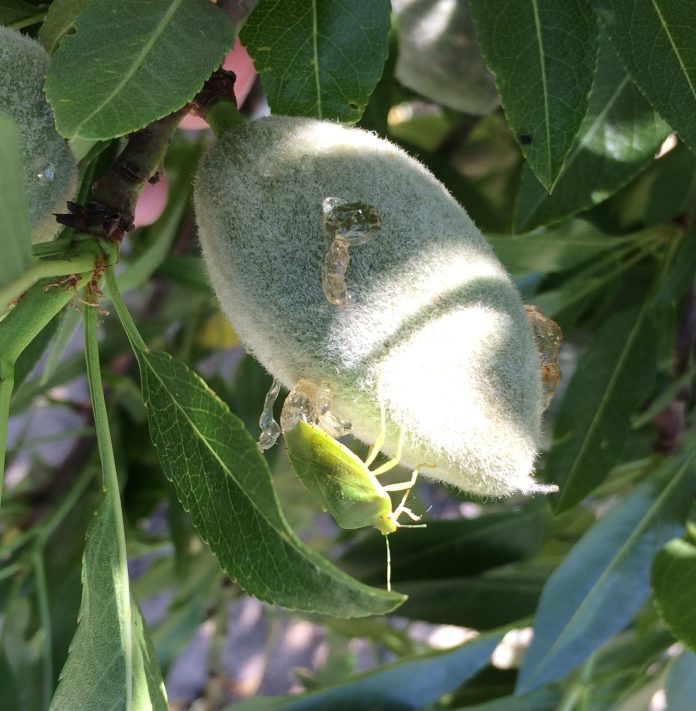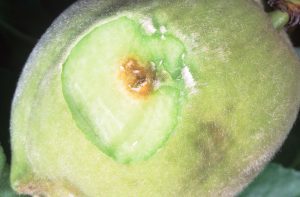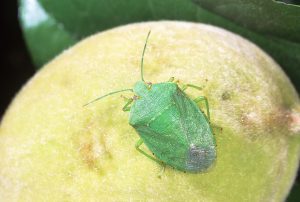
While navel orangeworm, leaffooted bugs and brown marmorated stink bugs grab the headlines and the attention of pistachio growers, another insect pest is gaining ground in California.
The green stink bug can quietly move into orchards, build numbers and cause crop damage mid- and late-season.
The green stink bug (Chinavia hilaris) was previously called Acrosternum hilare. Like other stink bugs, green stink bugs have the shield-like covering. Adults have bright green coloring with yellow or orange lining around the entire shield margin. Green stink bug nymphs are a mixture of green, black and orange.
Two other stink bug species similar to green stink bugs are Uhler’s stink bug (Chlorochroa uhleri) and Say’s stink bug (chlorochroa sayi). None of these pest stink bugs should be confused with the rough stink bug, Brochymena quadripustulata, a predator stink bug that is speckled white and gray and common in pistachio orchards throughout the year. Nymphs of this predator stink bug are red, white and blue. They do not prey on green stink bugs but rather are generalist predators.
“I am seeing a lot more of these green stink bugs in orchards this year compared to the last two or three years,” Jhalendra Rijal, UCCE area IPM advisor said. Rijal noted that in addition to pistachio, almond and peach orchards are experiencing infestations of this pest at a higher level than previous years.

Cause of Kernel Necrosis
Green stink bug feeding on pistachio nuts after shell hardening can cause kernel necrosis. This damage is similar to that caused by leaffooted bugs and results in rejection at the processor. The off-grade nuts may not be obvious at harvest. Green stink bug feeding in July and August can cause a pinpoint brown mark on the hull, or no external mark due to feeding will be readily visible. Cutting into the nut will show a darkened kernel with a sunken appearance near the feeding site. UC IPM Guidelines note that stink bug feeding on pistachio nuts can also transmit a type of yeast that causes a condition called Stigmatomycosis and Botryosphaeria panicle as well as shoot blight diseases.
PCA Justin Nay with Integral Ag said that the grade sheets from processors do not specify the source of the kernel damage, only noting the percentage of inedible nuts. He said it is likely that green stink bug feeding damage is underreported as it is not distinguished from navel orangeworm damage.

Green stink bugs can overwinter as adults in orchards and in dry vegetation outside of orchards. Rijal said there is evidence that this pest can spend winters hiding inside cracks in tree bark or in any vegetation on the orchard floor where they are protected from the elements.
As weather warms in the spring, green stink bugs move out of protected sites and begin to feed on weeds. After pistachio nut clusters begin to form, green stink bugs are among several species that feed on the developing nuts. This early feeding causes nuts to abort and drop, but due to the relatively low number of stink bugs typically found early in the season and the ability of pistachio trees to compensate for dropped nuts, bug damage prior to shell hardening does not often cause marked crop loss.
“Bug damage after the nut drop period and before shell hardening can cause damage, but that time tends to have low green stink bug populations.,” Rijal said. “However, this can vary among years and regions. Green stink bugs can still cause damage to pistachio after shell hardening (July to September), resulting in kernel necrosis. The green stink bug adult population also tends to be higher during that period.”
Green stink bugs lay barrel-shaped eggs with concentric dark rings at the top in clusters on foliage and vegetation about 17 days after emerging from overwinter sites. After hatching, the nymphs have a wide range of colors from red to black or brown.
Rijal said in his experience with nut orchards infested with green stink bugs, adult, nymph and egg stages can be seen at the same time, although nymph feeding damage late in the season is insignificant.
Parasitoid Activity
It is possible that parasitic wasps can be present in the orchard and lay eggs on green stink bug eggs, ultimately destroying the stink bug eggs. Rijal said he has collected green stink bug egg masses from an almond orchard and found very high parasitic activity. He said parasitoid species that attack the eggs need to be identified and research conducted to determine if this biological control can help reduce green stink bug populations in the orchard.
Rijal said monitoring for green stink bug should begin in April if a grower or PCA suspects damage from the previous harvest was caused by this pest.
Use of beating trays can show the presence of green stink bugs in an orchard. Rijal said green stink bugs are not strong fliers compared to leaffooted bugs and are relatively easy to find with a beat tray or sweep net. However, low numbers early in the season and trees’ compensation of the dropped nuts may not justify an insecticide application. Another monitoring method is to look for green stink bug eggs, nymphs and adults. From June onward, if green stink bugs are present, nuts can be inspected for kernel damage to confirm feeding damage. Lesions on the hulls may not appear right after green stink bug feeding.
Rijal said higher overwinter survival due to warm winters and applying fewer broad-spectrum insecticides that can disrupt the natural enemy populations in the orchard may be reasons for the uptick in green stink bugs populations.
Rijal said growers should take note of late-season green stink bug activity. Overwintering sites, other hosts and weeds, bug damage at harvest samples, etc. should help determine next season’s pest management plan.
The UC IPM guidelines note that insecticide applications should be timed after the majority of eggs have hatched and nymphs are easily found. Growers can still use insecticides mid-season to prevent kernel necrosis.










